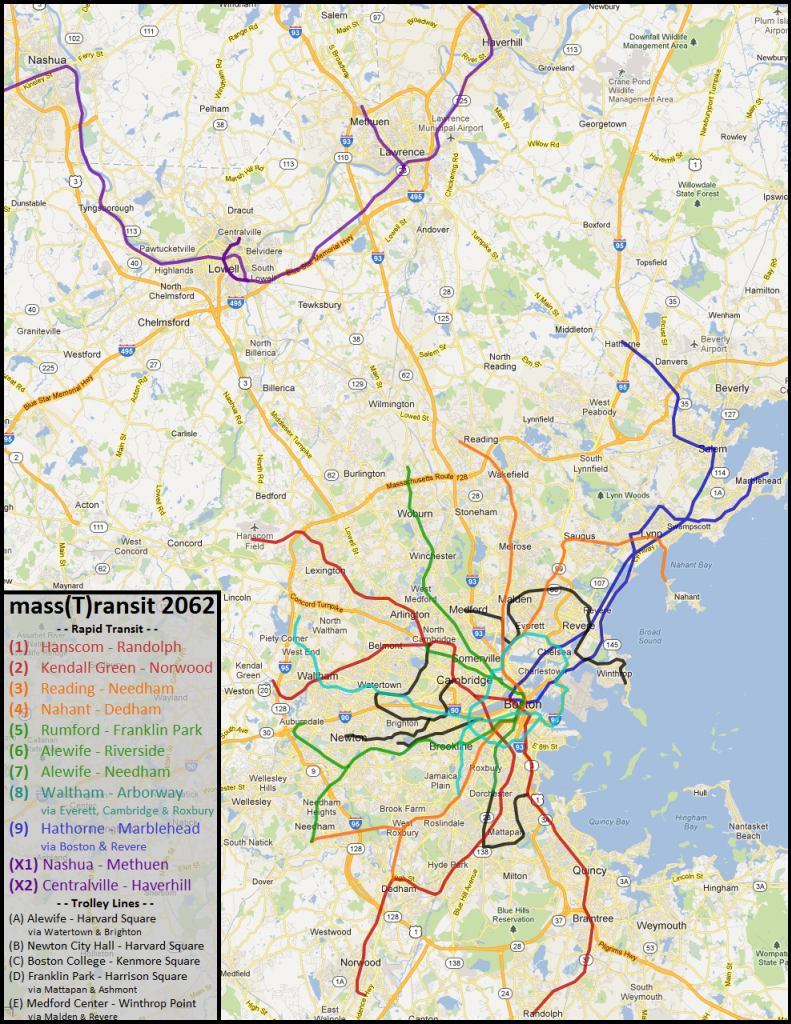Allright, I just had to redo all this so it would fit on one page.
EDIT (again): All the lines won't display on one page. I included a "page two" separate map, so if you want to save them both to your places you can view both maps at the same time using the layers panel in the upper right. Not ideal but it's the only thing I can figure out.
mass(T)ransit: 2050
Page Two
I completely did my fantasy map to include my new concept of the Teal "Turbine" Line. Essentially it runs from Waltham through the Boylston Street Subway, loops around the metro area, then runs back through the Boylston Street subway a second time before ending its run at Arborway. I love this because it combines the urban loop concept with rapid service through the Back Bay, eliminating the need for a second East-West line altogether. I even thought up a construction schedule that is independent of all other proposed extensions:
Phase 1:
-Construct Essex Street subway, connecting Post Office Square leads at Boylston to the South Station bus loop. Pedestrian concourse above connecting Boylston to Chinatown.
The shortest new construction but the most logistically complicated due to the mess of tunnels in Dewey Square and utilities under Essex St.
-Extend silver line tunnel to Black Falcon Pier, station near Summer St Bridge.
-Sink Tunnel Sections beneath the Harbor connecting Black Falcon Pier to the pier at Logan.
-Construct an EL from the logan pier to Airport station (to be renamed). Elevated station on west side of Central Parking. Possible station at Logan Pier.
-Cut and Cover Comm Ave subway to Union Square, Allston (single station stop)
-Extend trolley service as new (A) branch along completed project.
Phase 2:
-Extend El across Chelsea Creek, descend to existing ROW between Eastern Ave and Cottage Street. Station in this area.
-Extend at grade, swinging north under RT 1 and west towards RT 16. Station at Chelsea Station.
-Ascend to an elevated over RT 16 , station at or near Ferry Street. Continue EL across Mystic River, descend to at-grade station at Sullivan Square utilizing abandoned western tracks.
-Cut and Cover Comm Ave subway to Brighton Landing (station stop)
Phase 3:
-Cut and cover beneath the inner belt to Brickbottom, connection to Green Line.
-Cut and cover beneath the Grand Junction to the MIT athletic fields. (cut an cover is paramount, as I believe the GJ should be reserved for commuter trains to north station.)
-Stations at Cambridge Street, Reardon Square (pedestrian concourse under Broadway to Kendall), Mass Ave and Cambridgeport (near the atheltic field terminus)
-Cut and Cover under N Beacon Street to the other side of the pike, ascend to an elevated to cross the Charles. Descend into pit under the Arsenal Mall with a station stop.
-Cut and cover beneath Arsenal St and the Watertown Branch to Watertown Square. Stops at School St and the square.
Phase 4:
-Cut and cover from Courthouse Station to Washington Street, beneath Haul Road, Mass Ave connector and Melnea Cass.
-Demolish and cut and cover beneath the projects near Ruggles
-Cut and cover beneath Ruggles Street
-Station stops at Channel Center, Dorchester Ave (pedestrian concourse to Broadway utilizing former trolley tunnel), Mass Ave, Washington Street, Ruggles, and Huntington Ave.
-Extend (C) service along this routing.
Phase 5:
-Construct TBM launch boxes at MIT atheletic fields and the Landmark Center.
-dig station caverns beneath BU Central and Fenway.
-Deep Bore to connect both sides of the loop.
-Cut and Cover from the Pleasant Street portal to Huntington Ave along Marginal Road. Reroute the (E) here.
-Cut and Cover Huntington Ave subway to Brookline Village, swinging through Mission Park and the Brookline Ave playground to avoid deep boring.
-(A) and (C) now both loop, forming the turbine.
-Phase 6:
-Begin conversion of Boylston Street subway to Heavy Rail. Disconnect the Boylston curve, send all Tremont St trolley traffic [(D) and (E)] via the Pleasant St portal to the Huntington Ave subway. Turn the (C) at Kenmore and the (B) at Packards Corner (or Kenmore if surface routing remains intact).
-As an open cut extend the watertown Branch to Waltham, with a small yard beneath the common.
-Cut and Cover from the Brookline Ave playground beneath the Jamaciaway to the Heath Street Loop. (station stop)
-Heavy Rail begins, terminals at Waltham and Jamaciaway (Heath St) Cars would be blue line equipment, allowing the existing overhead to be used for power until end of life requires conversion to third rail
Phase 7:
-Deep bore beneath S Huntington and Centre St to Arborway. Station Stops at Perkins St, Pond St, South St and Arborway.
Phase 8:
-Cut and Cover beneath Lexington St and Totten pond Road, stops at Waltham Highlands, Piety Corner, and Prospectville.
-New at grade ROW under power lines to Trapello Road. Park and Ride for I95 and RT 2 at or near Trapello Road.
Success!
I think phases 1-6 could be done in 25-30 years. Phase 7 and 8 are independent extensions that would be provisioned for, but not a part of the core project.

